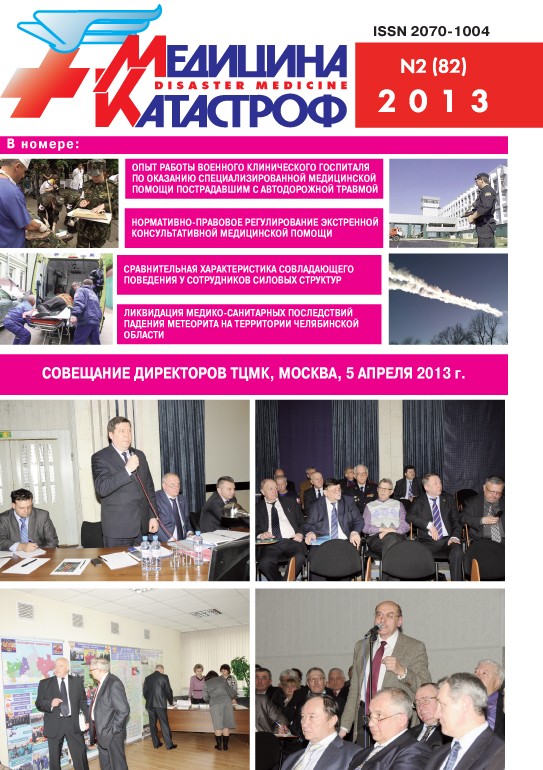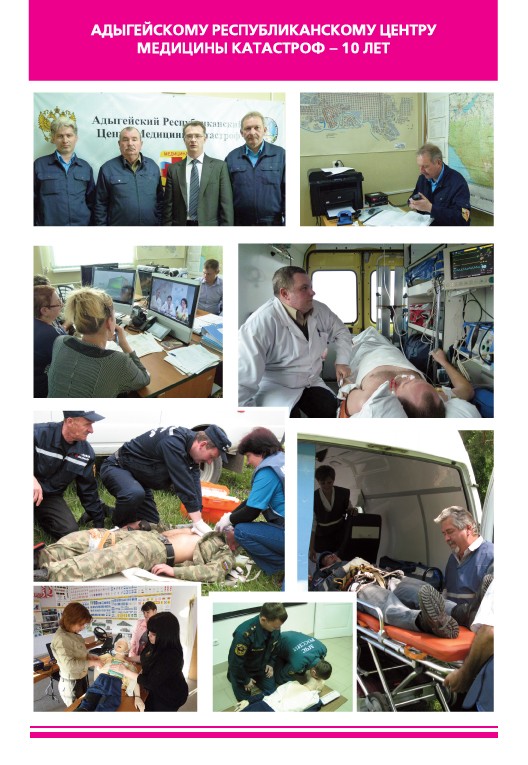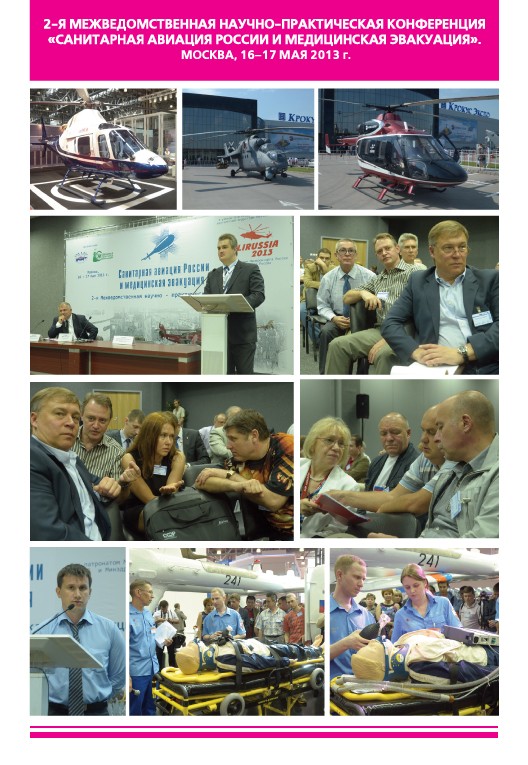ORGANIZATION AND TACTICS OF DISASTER MEDICINE SERVICE
1. Karant O.E. Disaster Medicine Center of Adygei Autonomous Region is 10
The history of creation and formation of disaster medicine center of Adygei Autonomous Region as well as its structure and spheres of activity are presented. The main results of the center’s activity during the 10 years of its existence are analyzed.
Key words: Adygei Autonomous Region, Adygei disaster medicine center, disaster medicine service, emergency situations, liquidation of medical and sanitary consequences, teaching and guiding activity
2.Lyutov V.V., Voynovsky A.E., Sushchenin A.A., Makhnovsky A.I., Plaksa I.L., Raguzin E.V. Experience of Activity of Military Clinical Hospital in Delivery of Specialized Medical Care to Road Traffic Accident Victims
The experience is presented of medical aid delivery to 548 casualties with road traffic accident traumas treated at 442th district military clinical hospital (St. Petersburg). It is noted that road traffic accident traumas are considered as a model of present-day combat traumas and treated in accordance with modern approaches of military field surgery to diagnostics and management of combat traumas and damages.
A conclusion is drawn on the expediency of the hospital’s inclusion into the territorial system of injury care centers of St. Petersburg.
Key words: 442th district military clinical hospital, casualties with road traffic accident traumas, road traffic accidents, specialized medical care
CLINICAL ASPECTS OF DISASTER MEDICINE
3. Prostakishin G.P., Sarmanaev S.Kh., Akhmetov I.R., Kovalyov E.V. Approaches to Identification of Needs in Antidotes in Management of Acute Damage by Chemical Agents
An analysis is presented of approaches to identification of needs in antidotes. The measures on realization of decision on setting up of adequate antidote reserves are defined.
Key words: acute damages, antidotes, chemical matters, demand, medical aid, reserves
4. Bezchastny K.V. Comparative Analysis of Coping Behavior of Power Structures Personnel
The results are presented of a study of coping behavior of personnel of different power structures. It is found that the variety of use of alternative forms of coping behavior of those surveyed is sufficient to state the presence of adaptation potential. A conclusion is drawn that learning of more efficient forms of coping in the process of occupational activity is a psychohygienic factor.
Key words: adaptation, coping behavior, power structures personnel, psychohygiene, stressful situations
5. Tetyushkin M.A., Gus’kova O.V., Budantseva L.B. Human Factor Impact on Implementation of Instructions by People in Hazardous Occupations
The role of human factor is shown in occurrence of emergency and crisis situations. A definition of human factor as an aggregate of a wide range of components is given. It is noted that a significant part of the human factor components are at the same time symptoms of nonpsychotic psychic disorders.
The results of a study are presented of prevalence of the disorders and their influence on implementation of instructions by people in hazardous occupations.
Key words: crisis situations, emergency situations, human factor, implementation of instructions, nonpsychotic psychic disorders, people in hazardous occupations
ACTUAL PROBLEMS OF EMERGENCY CONSULTATIVE MEDICAL CARE PROVISION AND OF MEDICAL EVACUATION
6. Garmash O.A. Normative Legal Regulation of Emergency Consultative Medical Aid
The data are presented on development of sanitary aviation in the USSR and in the post-soviet period in the Russian Federation. An analysis is done of the legal support of the sanitary aviation. The content of the notions “emergency consultative medical aid” and “medical evacuation” is discussed. The essence is substantiated of the suggestions sent to the Health Ministry on additions and amendments to the Federal Law on the Fundamentals of Protection of the Health of Citizens in the Russian Federation.
Key words: emergency consultative medical aid, Federal Law on the Fundamentals of Protection of the Health of Citizens in the Russian Federation, laws and regulations, medical evacuation, sanitary aviation, territorial centers for disaster medicine
SANITARY-ANTIEPIDEMIC (PREVENTION) MEASURES IN EMERGENCIES
7. Konyshev I.S., Agirov A.Kh., Murzin A.P., Tlyunyaeva A.K. Application of Modern Information Technology to Ensure of Sanitary and Epidemiological Welfare and of Biological Threats Countermeasures
The specific features of potential biological threats are discussed. The results of experimental exploitation of a system of information support of the agencies and institutions carrying out the state sanitary-epidemiological control in the Adygei Autonomous Region are analyzed.
Key words: Adygei Autonomous Region, biological terror acts, biological threats, information support system, state sanitary-epidemiological control
8. Suranova T.G. Training of Medical Professionals on Issue of Prophylaxis of Infections Related to Medical Aid Provision in Emergency Situations
The main tasks are discussed of training of medical personnel on the issues of prophylaxis of infections related to medical aid provision in emergency situations
Key words: disaster medicine, emergency situations, infections related to medical aid provision, prophylaxis, training of medical personnel
9. Konyshev I.I. Raising the Possibility of Private Organizations for the Disinfection Sanitary and Epidemiological Measures in Emergency Situations
The specifics are presented of carrying out complex disinfection measures while liquidating effective disease areas in emergency situations zones. The possibility of engagement of forces and facilities of nonstate disinfection organizations for liquidation of medical and sanitary consequences of emergency situations are discussed.
Some ways of adaptation of organizational and staff structure of nonstate disinfection organizations for optimal cooperation with formations of disaster medicine service are suggested.
Key words: disaster medicine service, disinfection measures, emergency situations, epidemics, nonstate disinfection organizations, organizational and staff structure, sanitary-epidemiological formations
SHORT REPORTS
10. Voinovsky E.A., Parkhomenko I.V. Technology of Single-Stage Vitreoretinal Intervention in Managing of Severe Combat Eye Wounds
A technology is presented of a single-stage vitreoretinal intervention in managing of severe combat eye wounds in servicemen of internal troops and in Internal Affairs Ministry personnel. A conclusion is drawn that the technology use fastens recovery, cuts frequency of complications and treatment expenses.
Key words: Internal Affairs Ministry personnel, servicemen of internal troops, severe combat eye wounds, silicon oil injection, single-stage vitreoretinal intervention
11. Gumenyuk S.A., Fedotov S.A., Kostomarova L.G., Shcharenskaya T.N. Fires as One of the Leading Causes of External Factor Traumatism in Population of Moscow
Some data are presented on number, medical and sanitary consequences of fires in Moscow in 2003-2011 and in 9 months of 2012. A regimentation is given by infrastructure facility types, administrative division and other categories.
Key words: casualties, fires, medical and sanitary consequences, Moscow, population, traumatism
12. Vedrintsev V.V., Gutsev A.N., Banin I.N., Vorobyov I.I., Balabaev G.A., Batkaev A.R., Osykovy A.V., Tkachyov A.P. Experience of Sanitary Aviation Evacuation in Voronezh Oblast
The issues of organization of sanitary aviation evacuation and of development of sanitary aviation in Voronezh Oblast are analyzed. The specifications are given of a modern medium-range turboprop aircraft Pilatus РС-12, used for intraregional, interregional and interstate sanitary aviation evacuation.
Key words: Pilatus РС-12 aircraft, sanitary aviation evacuation, sanitary aviation, Voronezh Oblast
REVIEWS
13. Dadaev A.Ya., Kerimov A.Z., Yusupova M.M., Khasikhanov S.S. Medical Management of Thorax and Abdomen Gunshot Wounds: Review of Literature
A review of literature on issues of medical management of thorax and abdomen gunshot wounds in the period between the end of XIX and the turn of the XXI c. is presented.
It is noted that gunshot wounds of thorax and abdomen always presented a problem for field and emergency surgery while their occurrence keeps on growth tendency in wars, local armed conflicts as well as in civil health service practice.
Key words: gunshot wounds of thorax and abdomen, local armed conflicts, medical aid, wars
EXPERIMENTAL STUDIES
14. Muratov Zh.K. Specifics of Strophanthin K Influence on Myocardial Contractive Activity in the Process of Adaptation of Animals to High-Mountain Environment
It is found that under the influence of strophanthin K mean, systolic and diastolic pressure in the left ventricle of animals adapted and not adapted to high-mountain environment go up against the background of bradycardia development. In the right ventricle of animals not adapted to the environment growth of mean, systolic and especially diastolic pressure is seen.
Key words: adaptation of animals to high-mountain environment, diastolic pressure, maximum pressure, mean pressure, myocardial contractive activity, strophanthin K, systolic pressure
IN ORDER OF DISCUSSION
15. Budantseva L.B., Scharenskaya T.N., Stazhadze L.L. Improving Information of Emergency Medical Care of Moscow: Summarizing List of Victims in Emergency Situations
The problems of the formation of the final lists of victims in emergency situations in Moscow. It is concluded that the use of information system for emergency medical services in Moscow, and in particular, the automated system “Emergency Medicine” speeds up and simplifies information exchange between agencies sempai, including the formation of the final lists of victims in emergency situations.
Key words: automated system “Emergency Medicine”, the identification of the victims, the final list of victims, medical organizations, Moscow, emergency medical services, information support system, emergency situations
INFORMATION
1. Improving the information system and emergency (operational) Emergency Response (meeting with the heads of regional centers for Disaster Medicine)
2. Prostakishin G.P., Zalogin I.A., Kapatsyna A.S. Elimination of the health consequences of chemical accidents in the Belgorod region
3. Kryukov V.I., Murin M.B. Special exercises to improve the readiness of health care to health-care provision of the XXVII World Summer Universiade (Kazan, 2013) and the XXII Olympic Winter Games (Sochi, 2014)




